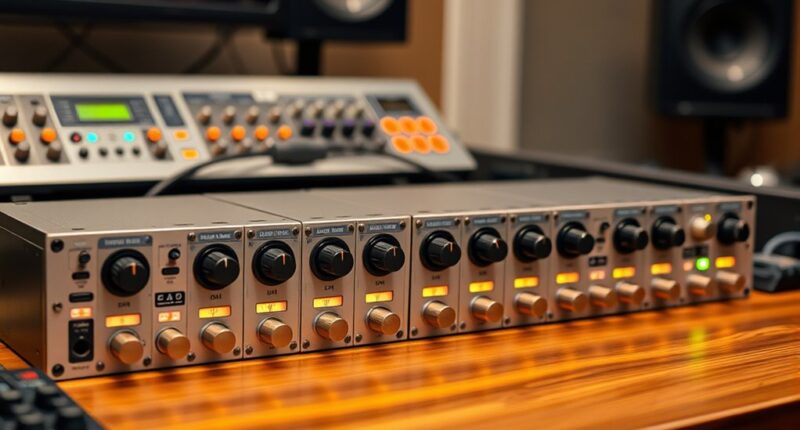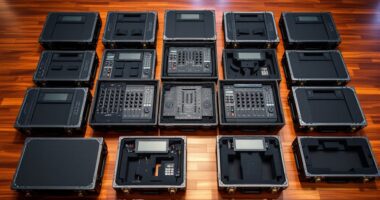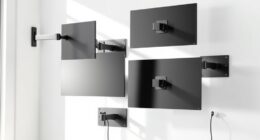If you’re looking for the best mic preamp desk units for studio-quality sound, I recommend checking out options like MC02 for basic needs, Depusheng MX2 for dynamic mics, and Behringer MIC500USB for warmth and USB versatility. StudioMan DPM1 offers low noise and high gain, while the MIC-1 provides up to 75dB of amplification. For multi-source setups, the Pyle rack-mounted preamp and LZSIG mixer are great choices. Keep reading to find the perfect match for your setup.
Key Takeaways
- Look for preamp units with high gain (up to +75dB) for optimal microphone sensitivity and studio-quality sound.
- Choose models with low noise and transparent audio for clear, professional recordings and streaming.
- Prioritize balanced outputs (XLR, 6.35mm) to ensure minimal interference and high-fidelity sound transfer.
- Consider units with multiple channels and adjustable gain controls for versatile studio and live setups.
- Select preamps featuring phantom power support for condenser microphones and enhanced studio compatibility.
Microphone Preamp with Phantom Power (MC02)
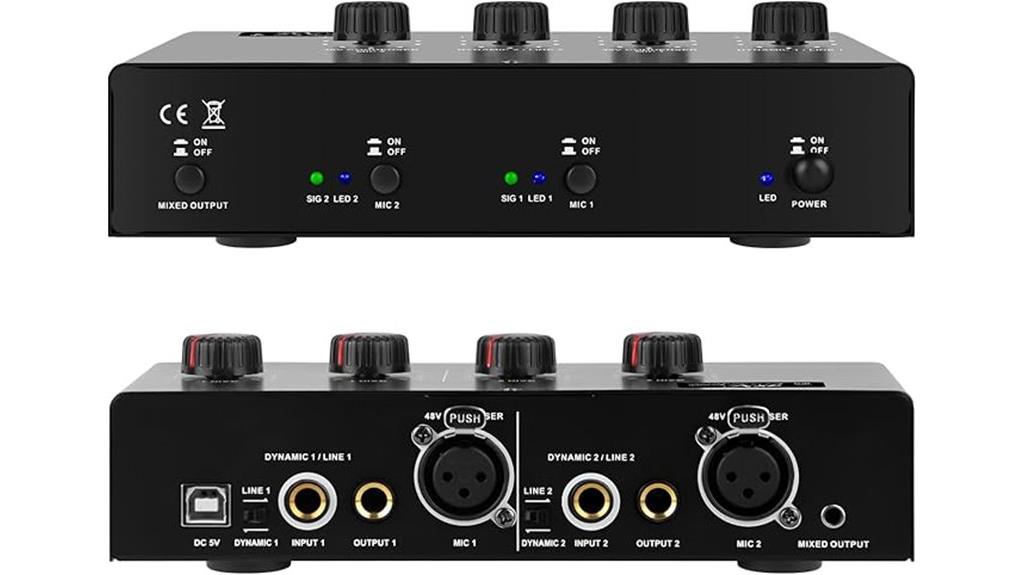
If you’re just starting out or need a basic preamp for home recording, the Microphone Preamp with Phantom Power (MC02) offers a straightforward solution. It features two channels that boost signals up to +25dB with clean, transparent gain, making it compatible with both dynamic and condenser mics like the SM7B and SM58. Supporting 48V phantom power, it’s versatile for various mic types. With XLR, 6.35mm stereo, and line outputs, you can connect it to audio interfaces, mixers, or speakers. While some find the design confusing, it provides low-noise, high-quality sound suitable for beginners, vocals, podcasts, and live streaming.
Best For: beginners and home recording enthusiasts seeking an affordable, straightforward microphone preamp with phantom power for vocal, podcast, or live streaming applications.
Pros:
- Compatible with both dynamic and condenser microphones, including popular models like SM7B and SM58
- Supports multiple outputs (XLR, 6.35mm stereo, line) for versatile connectivity
- Provides clean, low-noise gain up to +25dB suitable for various recording setups
Cons:
- Overpriced for basic preamp functionality, with better value found in mixers or multi-channel devices
- Design and control layout can be confusing, with upside-down markings and shared channels
- Lacks EQ features and professional-grade sound quality, limiting its use for advanced or studio-quality recordings
Depusheng MX2 Microphone Booster Preamplifier
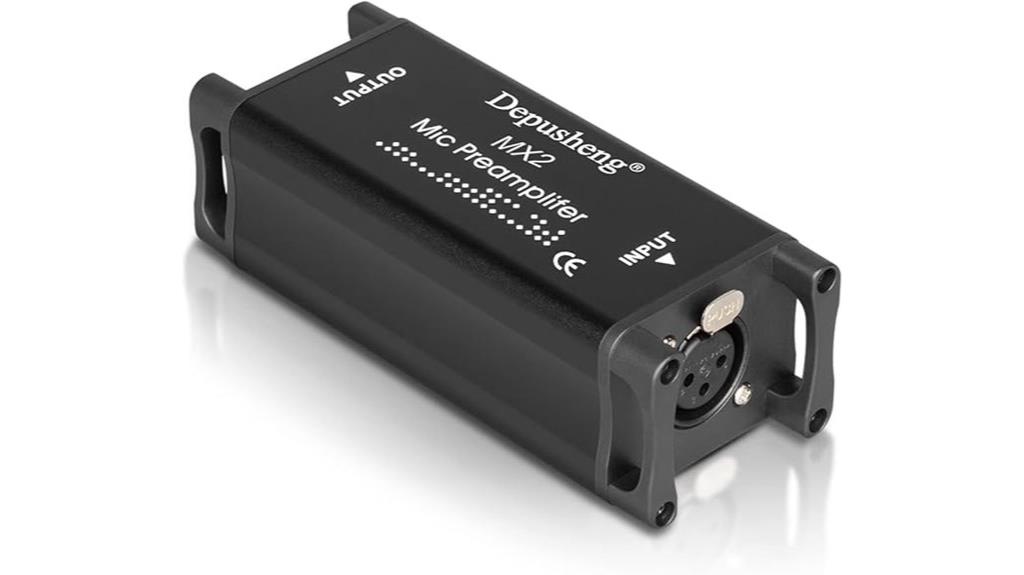
The Depusheng MX2 Microphone Booster Preamplifier is an excellent choice for those working with dynamic and ribbon microphones, thanks to its robust 25dB gain that guarantees clear voice reproduction. Its compact, durable aluminum design makes it perfect for studio, live, or broadcast environments. The built-in output buffer amplifier allows for long cable runs without RF interference, buzz, or hum, ensuring stable, high-quality sound. It requires 48V phantom power from your preamp, mixer, or interface—so verify compatibility first. Including a 31-inch balanced XLR cable, this preamp is ready for immediate use, offering reliable performance for professional audio applications.
Best For: musicians, podcasters, and audio engineers seeking a versatile preamp to enhance dynamic and ribbon microphones with clear, stable sound.
Pros:
- Provides a robust 25dB gain for clear voice reproduction
- Durable aluminum construction suitable for studio and stage use
- Built-in buffer amplifier minimizes RF interference and noise over long cable runs
Cons:
- Not compatible with condenser microphones, limiting versatility
- Requires 48V phantom power, so users must verify power supply compatibility
- Includes only a 31-inch cable, which may require additional accessories for some setups
Behringer MIC500USB Audiophile Vacuum Tube Preamplifier
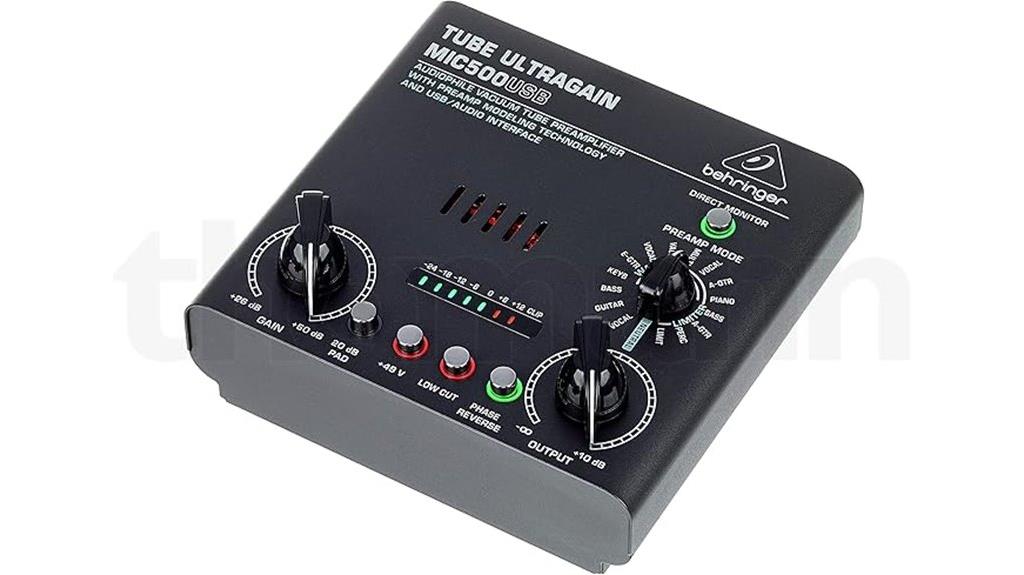
Designed for musicians and home recording enthusiasts seeking warm, tube-like sound on a budget, the Behringer MIC500USB audiophile vacuum tube preamplifier combines preamp modeling technology with USB/audio interface capabilities. It features two channels, phantom power, a 20 dB pad, and a low-cut filter, offering versatile connectivity and easy integration into any setup. Weighing just 1.54 pounds, it delivers respectable noise levels, enhanced headphone output, and the signature tube warmth ideal for vocals and guitars. While its USB interface is limited to 16-bit/48kHz and may produce some background hiss, it remains a solid choice for those wanting a warm sound without breaking the bank.
Best For: musicians and home recording enthusiasts seeking affordable, warm, tube-like sound with basic USB audio capabilities.
Pros:
- Offers warm tube sound and versatile connectivity options for vocals and guitars
- Compact and lightweight design, ideal for home studios and mobile setups
- Provides essential features like phantom power, 20 dB pad, and low-cut filter at an affordable price
Cons:
- Limited USB interface to 16-bit/48kHz, restricting high-fidelity recording quality
- Possible background hiss and static at high gain settings, affecting sound clarity
- USB output can be overly hot, causing high headphone volume even at low fader levels
Adjustable Electret Microphone Amplifier with 3.5mm Input
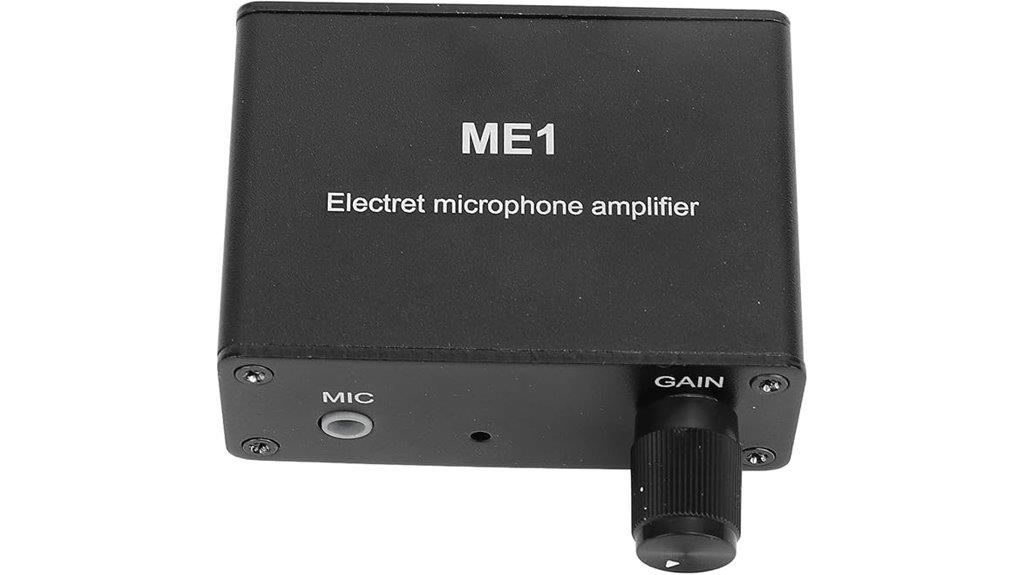
For musicians, podcasters, and content creators seeking a portable yet effective mic preamp, the Adjustable Electret Microphone Amplifier with 3.5mm Input offers a practical solution. Its compact design, weighing just 3.84 ounces, makes it easy to carry and set up anywhere. It features adjustable gain from 0-20dB, allowing for tailored sound enhancement, and a built-in bias supports diverse microphone types. The device connects via a 3.5mm interface and runs on a rechargeable 150mAh battery, providing over 10 hours of use. Simple to operate, it boosts microphone signals effectively, making it ideal for on-the-go recording, boosting low-volume inputs, or improving Bluetooth mic performance.
Best For: musicians, podcasters, and content creators seeking a portable, adjustable microphone preamp for enhanced sound quality on the go.
Pros:
- Compact and lightweight design for easy portability and setup.
- Adjustable gain from 0-20dB for tailored sound enhancement.
- Supports diverse microphones with built-in bias and 3.5mm connectivity.
Cons:
- Lacks a Type-C charging port, which could improve convenience.
- Moderate maximum gain may not suit all professional recording needs.
- No additional output options beyond 3.5mm interface.
StudioMan DPM1 XLR Microphone Preamp with 29dB Gain and Low-Noise Signal Boost
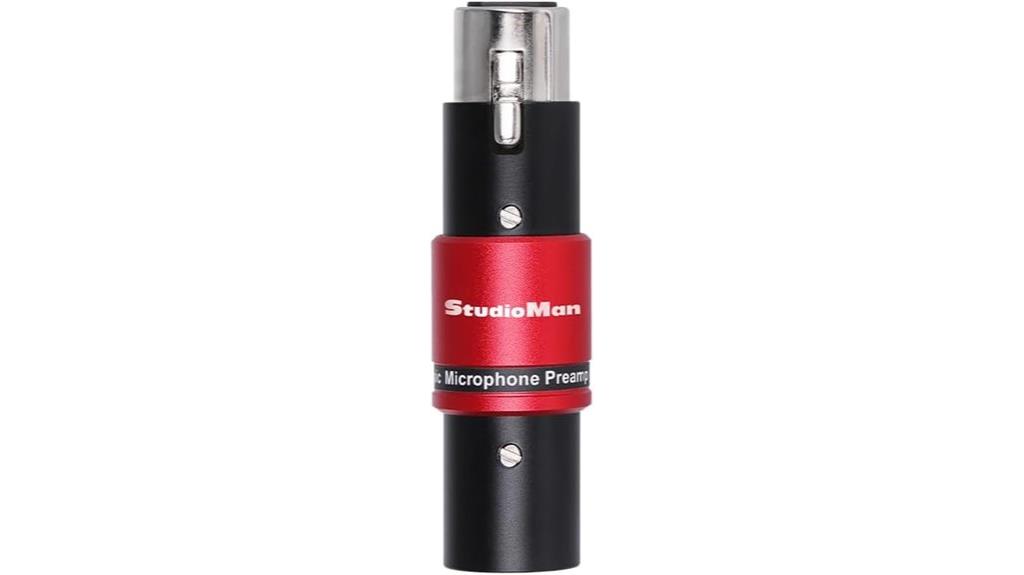
If you’re looking to improve the clarity and quality of your dynamic microphone recordings or live performances, the StudioMan DPM1 XLR Microphone Preamp is an excellent choice. Its all-metal, compact design makes it durable and portable, with a locking XLR connection to prevent accidental disconnections. The built-in low-noise circuit provides 29dB of clean gain, optimized for low-output microphones, and multi-stage filtering minimizes background noise. It’s compatible with popular dynamic mics like Shure SM7B and EV RE20, boosting signals without adding significant noise. Perfect for streaming, podcasting, and live gigs, it delivers professional sound enhancement in a small package.
Best For: musicians, streamers, and podcasters seeking to enhance the clarity and quality of their dynamic microphone recordings and live performances, especially with low-output or high-impedance mics.
Pros:
- Provides 29dB of clean, low-noise gain optimized for dynamic microphones
- Compact, durable all-metal design with locking XLR connector for secure connections
- Multi-stage filtering reduces background noise, delivering professional-grade sound
Cons:
- Does not support phantom power pass-through, limiting use with condenser microphones
- Not suitable for ribbon microphones or other gear requiring phantom power
- Limited to boosting low-output signals; not a substitute for high-gain interface preamps
Mic Preamp with Adjustable Gain, Phantom Power, and Line Out
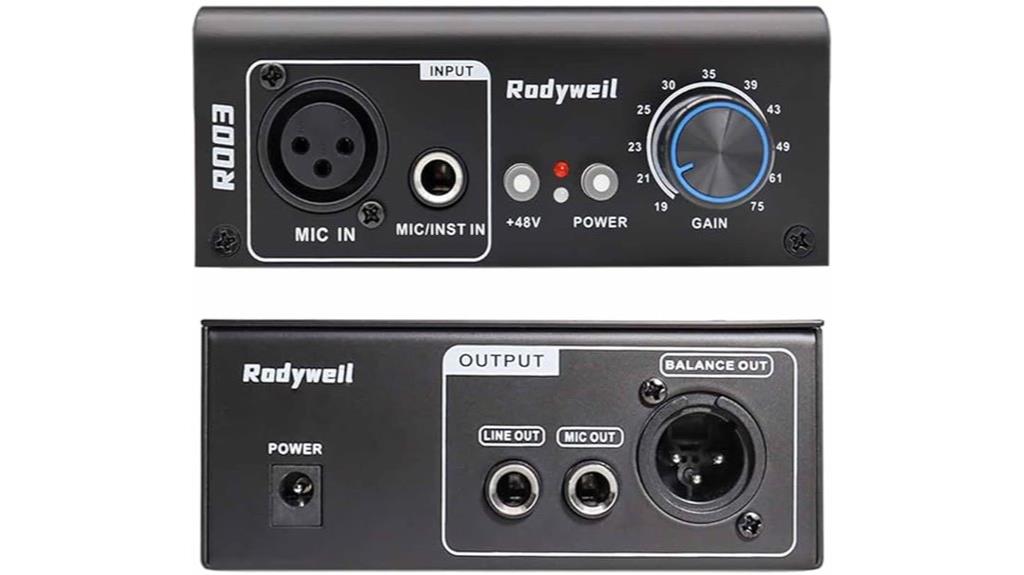
A mic preamp with adjustable gain, phantom power, and line out is essential for anyone seeking flexible control over their microphone signals. The Rodyweil RO-03 offers gain from 19 to 75dB, perfect for dynamic, condenser, or ribbon mics, and converts mic signals to line-level outputs via balanced XLR and 1/4″ connectors. It supports phantom power for condensers and can handle instrument signals through its 1/4″ input. Compact and durable, it’s ideal for studio, podcasting, or field recording. Just remember to monitor input levels to avoid distortion, and turn off phantom power when connecting to audio interfaces to minimize noise.
Best For: musicians, podcasters, and home studio users seeking a versatile, affordable microphone preamp with adjustable gain and phantom power.
Pros:
- Provides adjustable gain from 19 to 75dB, suitable for various microphone types and instruments
- Compact, durable metal construction with smooth controls for reliable use
- Converts mic signals to line-level outputs with high transparency and low noise when used properly
Cons:
- May produce high noise or hiss, especially with phantom power engaged or if unit is defective
- Unbalanced mini-jack outputs are less convenient than balanced connections
- Not compatible with mobile live-streaming interfaces or speakers without line inputs
MIC-1 Microphone Preamp with Phantom Power
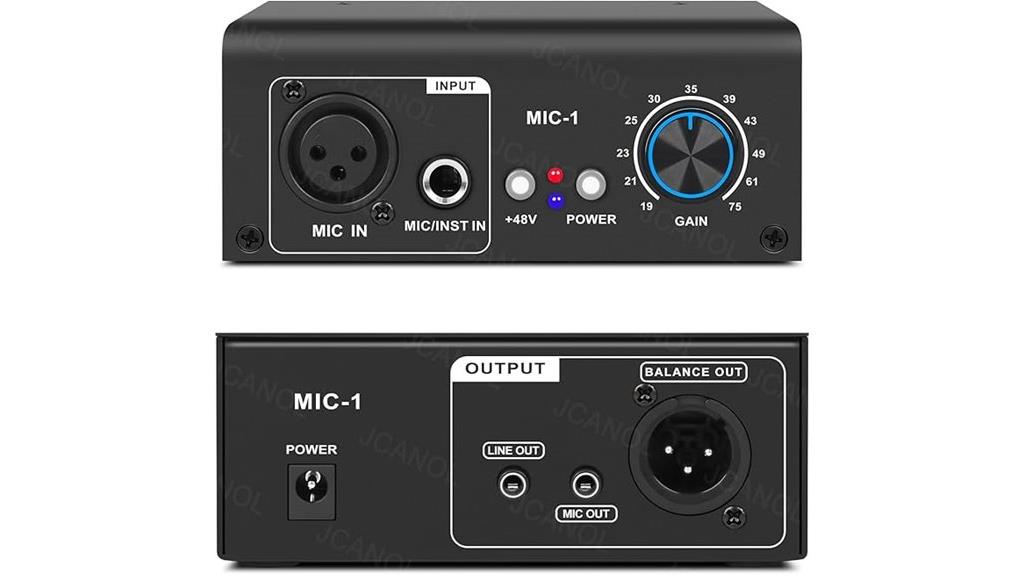
The MIC-1 Microphone Preamp with Phantom Power stands out as an excellent choice for home studio enthusiasts and podcasters who need reliable, high-quality sound without breaking the bank. It offers up to +75 dB of clean, transparent gain, ensuring accurate sound reproduction with low distortion and minimal latency. Its full balanced circuit design delivers professional-grade audio for vocals, streaming, or live recordings. Compatible with both dynamic and condenser mics, it provides 48V phantom power and multiple outputs, including XLR and 6.35mm jacks. Small, sturdy, and straightforward to operate, the MIC-1 delivers excellent value and performance for a range of audio setups.
Best For: home studio enthusiasts, podcasters, and live streamers seeking affordable, high-quality microphone preamplification.
Pros:
- Up to +75 dB clean, transparent gain ensures clear audio.
- Full balanced circuit design for professional-grade sound quality.
- Compatible with both dynamic and condenser microphones, with phantom power support.
Cons:
- Slight ambiguity regarding whether the instrument input is balanced or unbalanced.
- Minimal documentation may require users to seek online resources for setup guidance.
- Power-on pop noise, though minor, may be noticeable during operation.
Dual NE5532 Preamplifier Board (AC5-16V/DC6-24V) Microphone Audio OP AMP
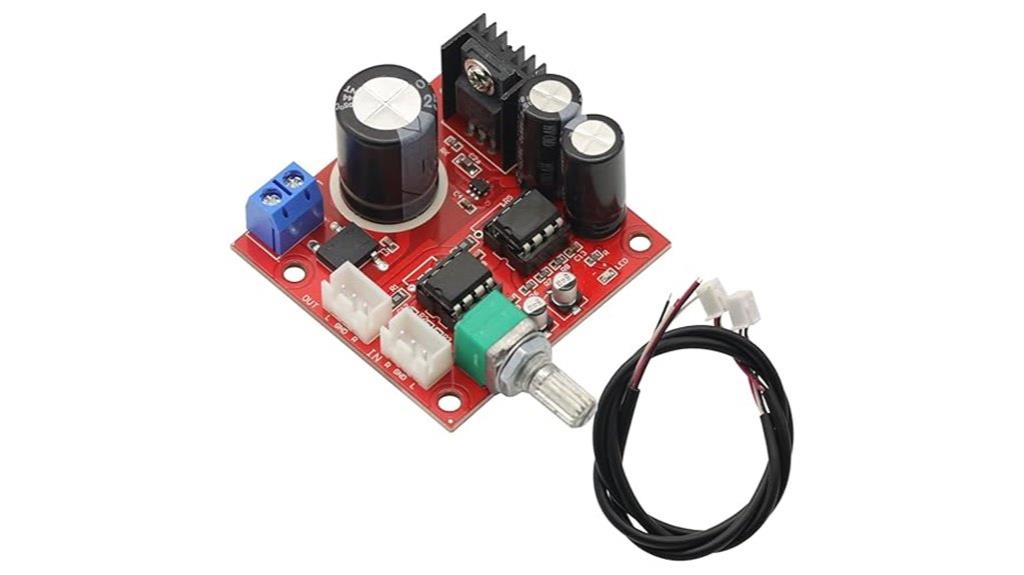
For audio enthusiasts seeking customizable gain and reliable performance, the Dual NE5532 Preamplifier Board stands out as an excellent choice. It features two NE5532 op amps, offering superior stereo clarity and easy replacement thanks to its socketed design. The board supports a wide power range, from AC5-16V or DC6-24V, ensuring compatibility with various setups. Amplification is adjustable via resistors R1 and R5, enabling precise control over gain—defaulting to about five times. Compact at 50mm x 50mm, it integrates smoothly into different audio projects and delivers consistent, high-quality sound, making it a versatile addition to any DIY studio system.
Best For: audio enthusiasts and DIY audio project builders seeking customizable gain and reliable stereo sound performance.
Pros:
- Features two socketed NE5532 op amps for easy replacement and upgrade.
- Supports a wide voltage range (AC5-16V/DC6-24V), ensuring versatile compatibility.
- Adjustable gain via resistors R1 and R5 allows precise customization for different applications.
Cons:
- No included datasheet, which may require users to find technical details online.
- Slightly compact size may limit integration with larger or more complex systems.
- Default gain is fixed at approximately five times, requiring resistor replacement for higher amplification.
MB-2 Dual Channel Microphone Preamp Booster
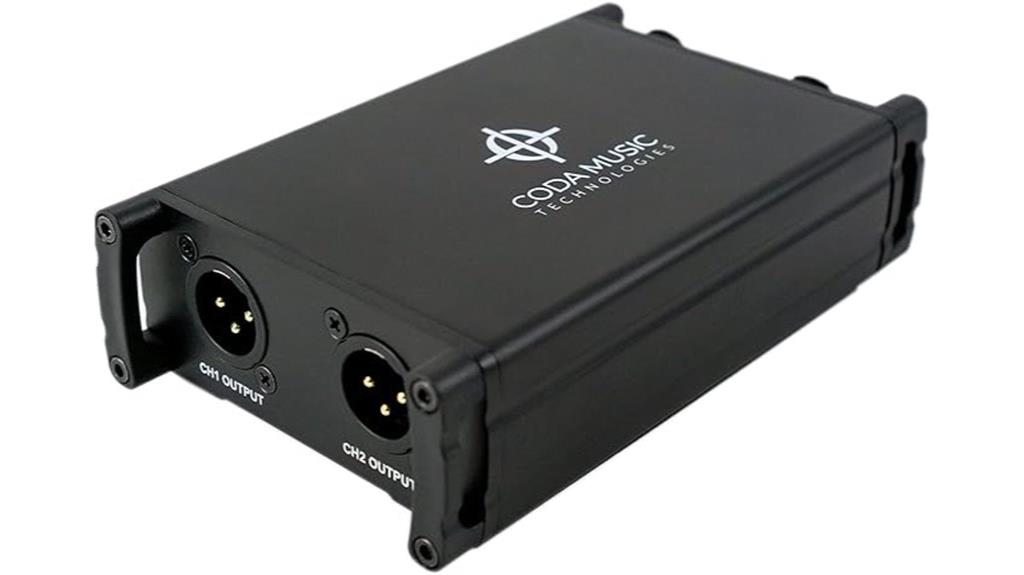
If you’re seeking a reliable, cost-effective way to boost microphone signals in your studio or live setup, the MB-2 Dual Channel Microphone Preamp Booster stands out as an excellent choice. It adds 25dB of clean gain using external phantom power, reducing noise to -70dB, and works well with dynamic and ribbon mics. Its dual-channel design allows simultaneous boosting of multiple mics, making it versatile for podcasting, streaming, or live performances. Built with durable aluminum, it offers professional connectivity through 3-pin XLR connectors. Overall, the MB-2 delivers clear, noise-free sound enhancement at an affordable price, ideal for both amateurs and professionals.
Best For: podcasters, streamers, and live sound engineers seeking an affordable, reliable microphone booster for dynamic and ribbon mics.
Pros:
- Delivers 25dB of clean gain with minimal noise (-70dB)
- Dual-channel design boosts multiple microphones simultaneously
- Durable aluminum housing with professional XLR connectors
Cons:
- Requires external phantom power supply; no built-in power option
- Larger size may limit portability and space in portable setups
- Lacks onboard gain control, which could be helpful during live adjustments
Mic Amplifier, DC 5V Microphone Amplifier High Gain Audio Amp 1000x
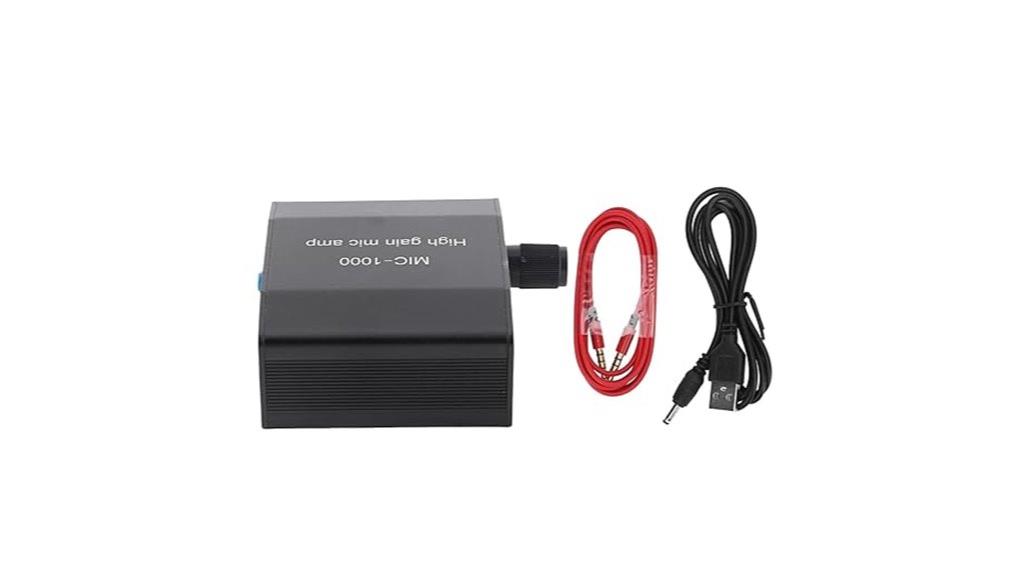
This mic amplifier stands out for its high gain of 1000x, making it ideal for musicians, podcasters, or anyone needing to capture faint sound sources with clarity. Designed to work with 3.5mm microphones, it offers automatic level control to prevent distortion and ensure consistent audio quality. Its compact, stylish aluminum alloy shell not only looks good but also provides excellent heat dissipation and minimizes interference. Powered by a built-in rechargeable 250mAh battery, it’s portable and easy to use on the go. The package includes a power cord and headphone cable, making setup straightforward and convenient for various recording environments.
Best For: musicians, podcasters, and recording enthusiasts who need a portable, high-gain microphone amplifier for capturing faint sounds with clarity.
Pros:
- High amplification of 1000x ensures clear capture of weak sound sources
- Compact, lightweight design with stylish aluminum alloy shell for portability and heat dissipation
- Features automatic level control (ALC) to prevent distortion and maintain consistent audio quality
Cons:
- Limited to 3.5mm microphones, which may restrict compatibility with some devices
- Battery capacity of 250mAh may require frequent recharging for intensive use
- No mention of additional input/output options for expanded connectivity
MIC-1 Microphone Preamp with 75dB Gain and Phantom Power
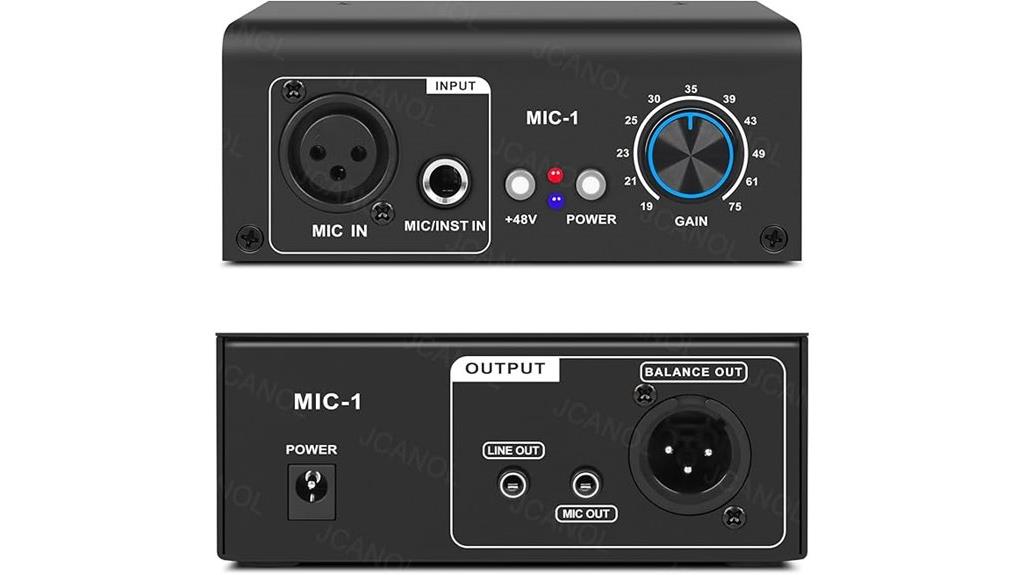
The MIC-1 Microphone Preamp stands out for its impressive 75dB gain, making it an excellent choice for anyone seeking studio-quality sound on a budget. It provides clean, transparent amplification with low distortion, suitable for vocals, podcasts, and live streaming. Its full balanced circuit design ensures high-quality audio, compatible with dynamic and condenser microphones thanks to 48V phantom power. The device offers multiple outputs, including XLR and 6.35mm jacks, and is housed in a sturdy metal shell that minimizes interference. Its portability, ease of use, and high performance make it a versatile, reliable tool for both home studios and mobile setups.
Best For: Home studio enthusiasts, podcasters, and live streamers seeking high-quality microphone amplification at an affordable price.
Pros:
- Provides a clean, transparent 75dB gain suitable for a variety of microphones
- Full balanced circuit design minimizes noise and interference for professional sound quality
- Compact, lightweight, and durable metal housing ideal for portable use and easy integration
Cons:
- Slight ambiguity regarding the input type on the instrument jack may require testing
- Minimal documentation can pose initial setup challenges for some users
- Power-on pop noise reported by some users, though it does not affect overall performance
Pyle Rack Mount Studio Pre-Amplifier with Bluetooth and USB Input
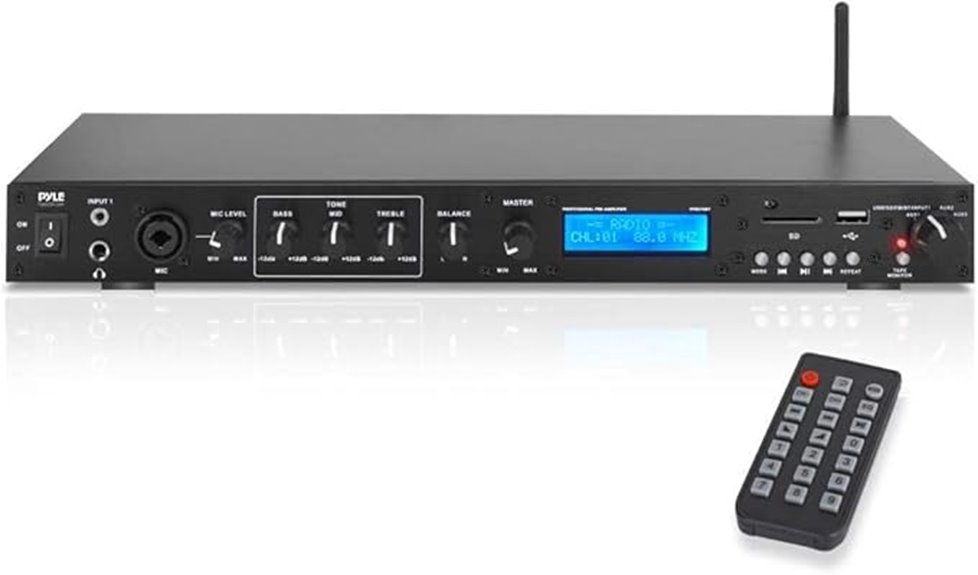
For those seeking a versatile and budget-friendly preamp with modern connectivity options, the Pyle Rack Mount Studio Pre-Amplifier with Bluetooth and USB Input stands out. It supports rack mounting and offers multiple inputs, including RCA, XLR, and combo microphone jacks, along with Bluetooth streaming and USB/SD media playback. Its digital display, FM radio, and recording capabilities make it a multifunctional device, ideal for both studio and home use. Users praise its sound quality and strong Bluetooth connection, though some note build quality concerns and limited remote control functions. Overall, it’s a practical, affordable option for expanding audio setups with modern features.
Best For: audiophiles and audio professionals seeking a versatile, budget-friendly preamp with modern connectivity and recording features for studio or home use.
Pros:
- Supports multiple input/output options including Bluetooth, USB, SD card, RCA, and XLR for flexible connectivity
- Strong Bluetooth streaming range with easy control via remote, enhancing wireless media playback
- Built-in FM radio with ID3 tag readout and recording capabilities for media versatility
Cons:
- Limited remote control functions, primarily only managing Bluetooth and input switching
- Build quality is considered low to moderate, with some users reporting initial delivery issues such as scratches or missing parts
- Lacks features like preset radio stations and tape deck monitoring, which may limit functionality for some users
LZSIG Mini Audio Mixer, 4-Channel Stereo Line Mixer
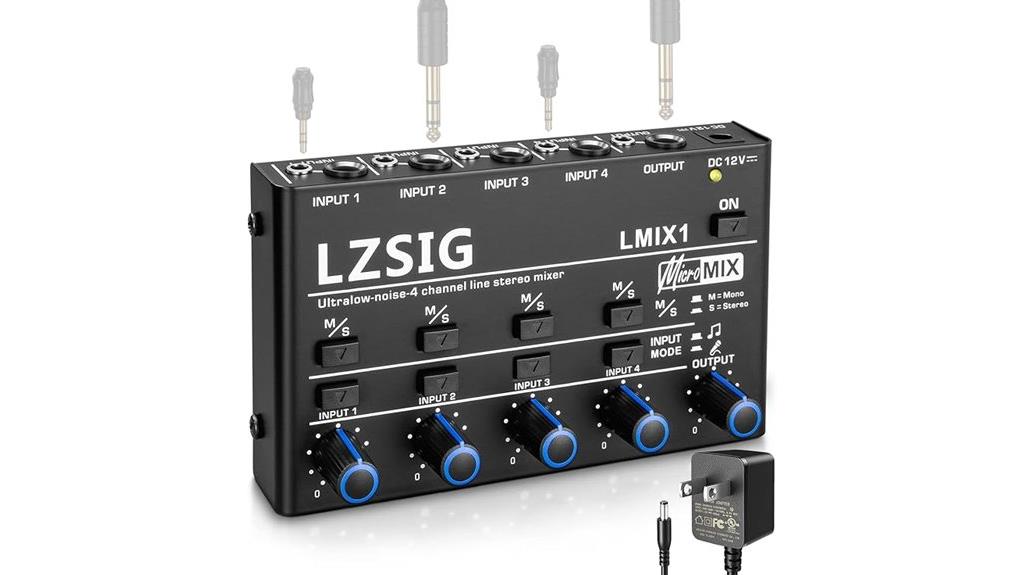
If you’re looking to expand your audio setup with a versatile and reliable mixer, the LZSIG Mini Audio Mixer stands out thanks to its 4-channel stereo line capability. It handles multiple sources like microphones, keyboards, computers, and gaming consoles effortlessly, supporting both mono and stereo modes without adapters. The mixer delivers professional-grade sound with ultra-low noise thanks to its high-quality components, including ROHM low-noise op-amps. Its independent channel controls and dedicated mic input make it flexible for live streaming, podcasts, or small performances. Compact and easy to use, it’s a practical addition for anyone seeking clear, high-quality audio mixing in a small footprint.
Best For: small-scale audio enthusiasts, podcasters, streamers, and live performers seeking a compact, versatile, and high-quality mixer for multiple audio sources.
Pros:
- Supports multiple input sources including microphones, keyboards, computers, and gaming consoles, with mono/stereo switching.
- Equipped with high-quality ROHM low-noise op-amps ensuring ultra-low noise and clear sound output.
- Compact design with independent channel controls, ideal for various environments from studios to live events.
Cons:
- The power adapter may vary in version, requiring customer assistance for compatibility issues.
- Limited to 4 channels, which might not be sufficient for larger or more complex setups.
- No built-in effects or advanced routing options, making it less suitable for highly complex audio productions.
Factors to Consider When Choosing Mic Preamp Deskunits
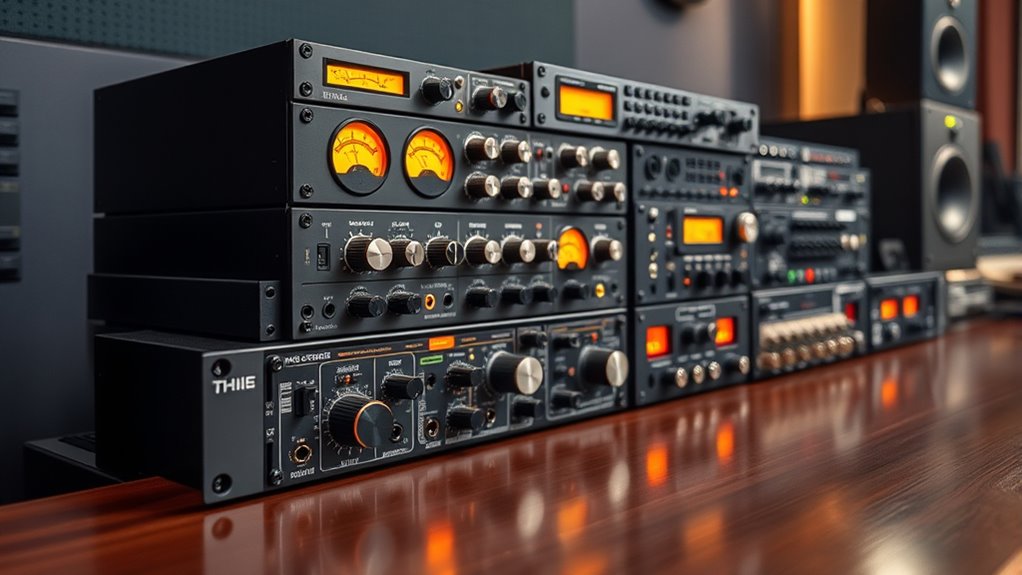
When selecting a mic preamp desk unit, I focus on key factors like gain range flexibility, phantom power support, and noise floor levels to guarantee clear, professional sound. Compatibility with different microphone types and the available connectivity options also matter, as they influence versatility and ease of use. Considering these points helps me choose a unit that best matches my recording needs and setup.
Gain Range Flexibility
A flexible gain range is essential because it allows you to fine-tune your microphone’s output to match the preamp’s input, ensuring clear, distortion-free sound. Look for preamps with a wide gain adjustment, typically from around 10dB to 75dB, to handle various microphone sensitivities. Variable gain control helps optimize sound quality across different sources, like dynamic or condenser mics, without needing extra gear. Precise gain adjustment also ensures compatibility with other audio equipment, maintaining proper signal levels throughout your setup. Preamps with adjustable gain ranges offer greater versatility for both studio and live environments, adapting seamlessly to changing recording conditions. This flexibility ultimately results in cleaner, more professional recordings and a more efficient workflow.
Phantom Power Support
Are you sure your mic preamp supports phantom power? If you’re using condenser microphones, this feature is essential. Phantom power supplies 48V DC, enabling active circuitry in condensers, which dynamic and ribbon mics typically don’t need. Not all preamps include phantom power, so check before buying. Many units have a switch or button to turn it on or off, offering flexibility for different mic types. Using phantom power with microphones that don’t require it can cause unwanted noise or even damage certain models. If you plan to work with condensers, make sure your preamp explicitly supports phantom power and that you know how to activate or deactivate it properly. Proper support ensures your microphones perform well and your recordings stay clean.
Noise Floor Levels
Choosing a mic preamp with a low noise floor is essential for capturing clean, detailed recordings. A lower noise floor means less background hiss and static, resulting in clearer sound. Professional preamps often have a noise floor below -100dB, ensuring high fidelity even with quiet sources. The noise floor directly impacts the dynamic range; a higher level reduces your ability to record subtle nuances accurately. When selecting a preamp, compare its specified noise floor to your recording environment’s sensitivity needs. Keep in mind that ambient noise and cable quality can influence the effective noise level, so it’s important to weigh your setup as a whole. Prioritizing a low noise floor helps you achieve the pure, professional sound you’re aiming for.
Compatibility With Microtypes
When selecting a mic preamp, it’s crucial to guarantee it supports the specific microphone types you’ll be using, such as dynamic, condenser, ribbon, or electret microphones. Different mic types have unique requirements; for example, condensers need phantom power (48V), which most preamps provide, but ribbons typically don’t and can be damaged by phantom power. Check if the preamp’s gain range aligns with your microphone’s output level to avoid distortion or weak signals. Also, ensure the input connectors, like XLR or 1/4-inch jacks, match your microphone’s output. Some preamps accommodate multiple microphone types simultaneously, while others require specific configurations. Being mindful of these compatibility factors helps you select a unit that seamlessly integrates with your existing gear and delivers optimal sound quality.
Connectivity Options
Selecting a mic preamp isn’t just about compatibility with microphone types; it also involves guaranteeing the unit has the right connectivity options to fit seamlessly into your setup. You’ll want compatible output connectors like XLR, 1/4 inch TRS, or mini-jack to match your audio equipment. If you plan to use condenser mics, phantom power support is essential. Balanced outputs help reduce noise and interference during longer cable runs, ensuring cleaner sound. Additionally, check for extra input options like instrument or line-level inputs, offering greater flexibility. Features like direct outputs or multiple channels can streamline complex audio setups. Prioritizing these connectivity options ensures your preamp integrates smoothly with your gear, delivering reliable, studio-quality sound without technical hiccups.
Size and Portability
If you’re frequently on the move or working in tight spaces, size and portability become essential factors in your mic preamp choice. Smaller units are easier to transport, making them perfect for mobile recording sessions or live gigs. Compact designs also save valuable space on crowded desks or in rack setups, ideal for home studios with limited room. Lightweight preamps reduce fatigue when carrying equipment between locations. Many portable models feature integrated power supplies, eliminating the need for bulky external adapters and simplifying setup. The size and form factor can also impact how smoothly your gear integrates into complex or tight setups. Overall, choosing a preamp that balances quality with portability ensures you stay flexible, whether in the studio or on the road.
Build Quality Durability
Building a durable mic preamp is essential because it guarantees reliable performance over time, even with frequent handling and transport. A sturdy metal construction or reinforced housing protects the unit from physical damage, ensuring longevity. High-quality components like premium capacitors and resistors contribute to consistent performance and reduce the risk of failure. Solid connectors and secure mounting options prevent damage and maintain stable connections, which is critical during regular use. Additionally, good build quality minimizes electromagnetic interference, leading to cleaner sound and lower noise levels. Investing in a preamp with robust construction means it will stay functional and maintain ideal audio fidelity over years of demanding studio use. Durability directly impacts reliability, making it a necessary factor when selecting a high-performance mic preamp.
Price and Value
Price and value are essential factors when choosing a mic preamp because a higher price often reflects better components, lower noise, and more durable construction. Investing in a more expensive unit typically means you’ll get superior gain range, phantom power options, and connectivity, which can enhance your recordings. While budget preamps might seem attractive, they often lack advanced noise reduction or signal clarity, making them less cost-effective for professional work. It’s important to compare features and read user reviews or benchmarks to see if a pricier preamp offers noticeable improvements. Ultimately, the value depends on balancing cost with technical specs, how you’ll use the preamp, and its long-term reliability. A well-chosen preamp provides better sound quality and durability, justifying its price.
Frequently Asked Questions
What Are the Key Differences Between Tube and Solid-State Preamps?
Tube preamps tend to add warmth, character, and a natural saturation to recordings, making vocals and instruments sound richer. Solid-state preamps offer cleaner, more transparent sound with higher headroom and greater consistency. I prefer tube preamps for their musical vibe, but I choose solid-state when I need accuracy and clarity. The main difference lies in their warmth versus transparency, and your choice depends on the sound you’re aiming for.
How Does Phantom Power Affect Different Microphone Types?
Phantom power supplies 48V to condenser microphones, which need it to operate, but it can damage most ribbon and dynamic mics. I always check my mic’s specifications before applying phantom power. Condenser mics rely on it for power, while ribbon and dynamic mics usually don’t need it and can be harmed if exposed. So, I make sure to turn phantom power on only when using compatible microphones.
Can These Preamps Be Used for Live Sound or Only Studio Recording?
These preamps can be used for both live sound and studio recording. I’ve found that they’re versatile enough to handle live performances, providing clear, reliable sound, and they excel in studio settings for detailed recordings. Just keep in mind that some models are optimized more for one environment, so it’s worth choosing a preamp with features suited to your specific needs. Overall, they’re adaptable tools for various audio applications.
What Is the Typical Lifespan of a Mic Preamp’s Components?
The typical lifespan of a mic preamp’s components varies, but most can last 10 to 20 years with proper care. I’ve found that solid-state preamps tend to be more durable, while tube-based preamps may need occasional tube replacements after several years of use. Regular maintenance, avoiding power surges, and keeping the equipment clean helps extend their longevity, ensuring your preamp continues delivering studio-quality sound for years to come.
Are There Any Compatibility Issues With Modern Audio Interfaces?
Like a bridge connecting two islands, modern audio interfaces are generally compatible with most mic preamp desk units. I haven’t faced many issues, but it’s wise to check the input/output types and verify voltage levels match. Some vintage preamps might need adapters or specific cables. Always double-check specifications and compatibility guides to avoid surprises, especially when integrating older gear with newer digital systems.
Conclusion
Choosing the right mic preamp can transform your recordings from good to studio-quality magic. Think of it as the secret ingredient in your audio recipe—powerful, essential, and often overlooked. Whether you’re after clean clarity or warm vintage tones, there’s a perfect unit for you. Don’t settle for less; elevate your sound today. After all, isn’t your voice worth the best? Your perfect mic preamp awaits—step up and make your sound legendary.
